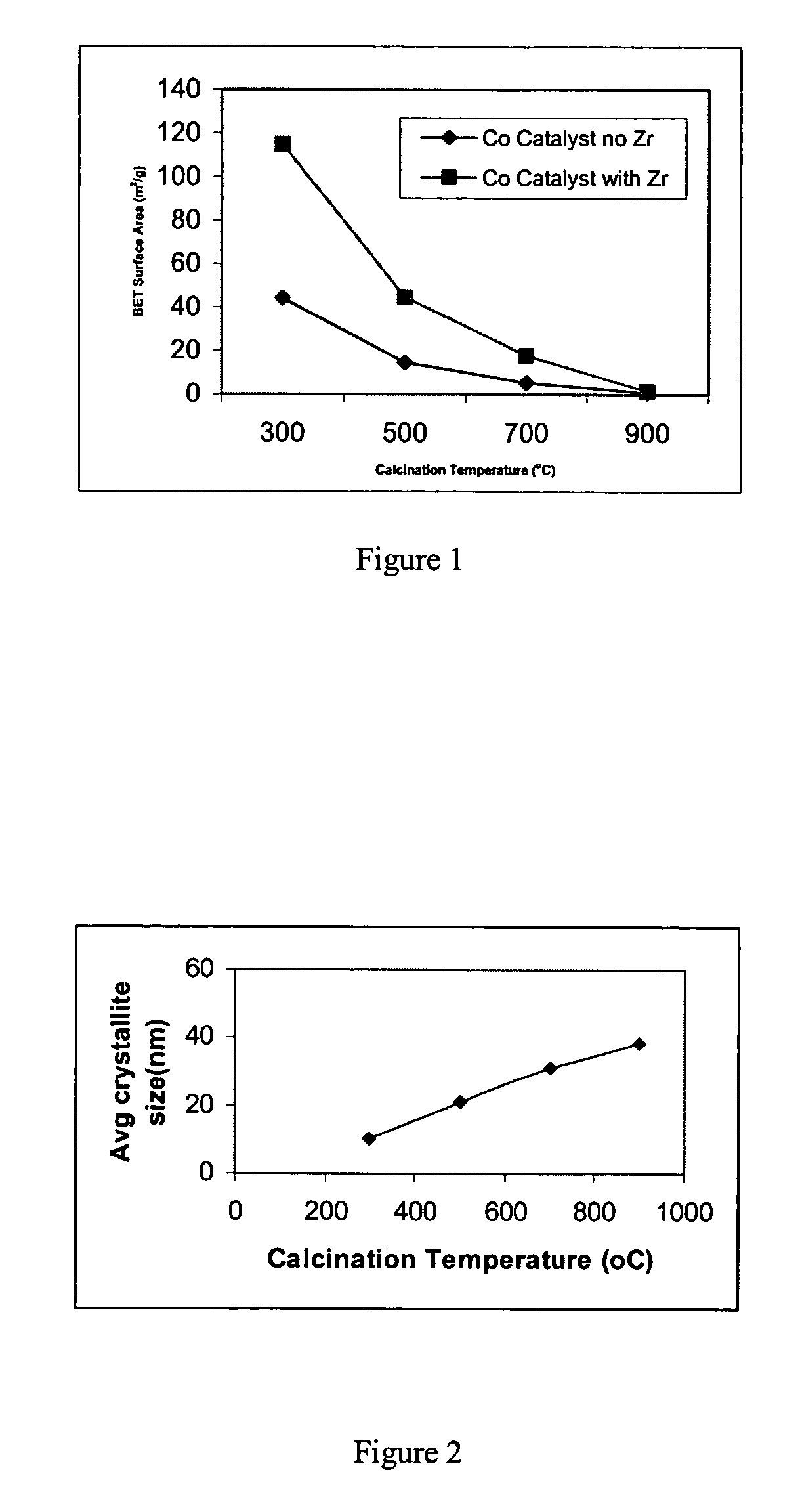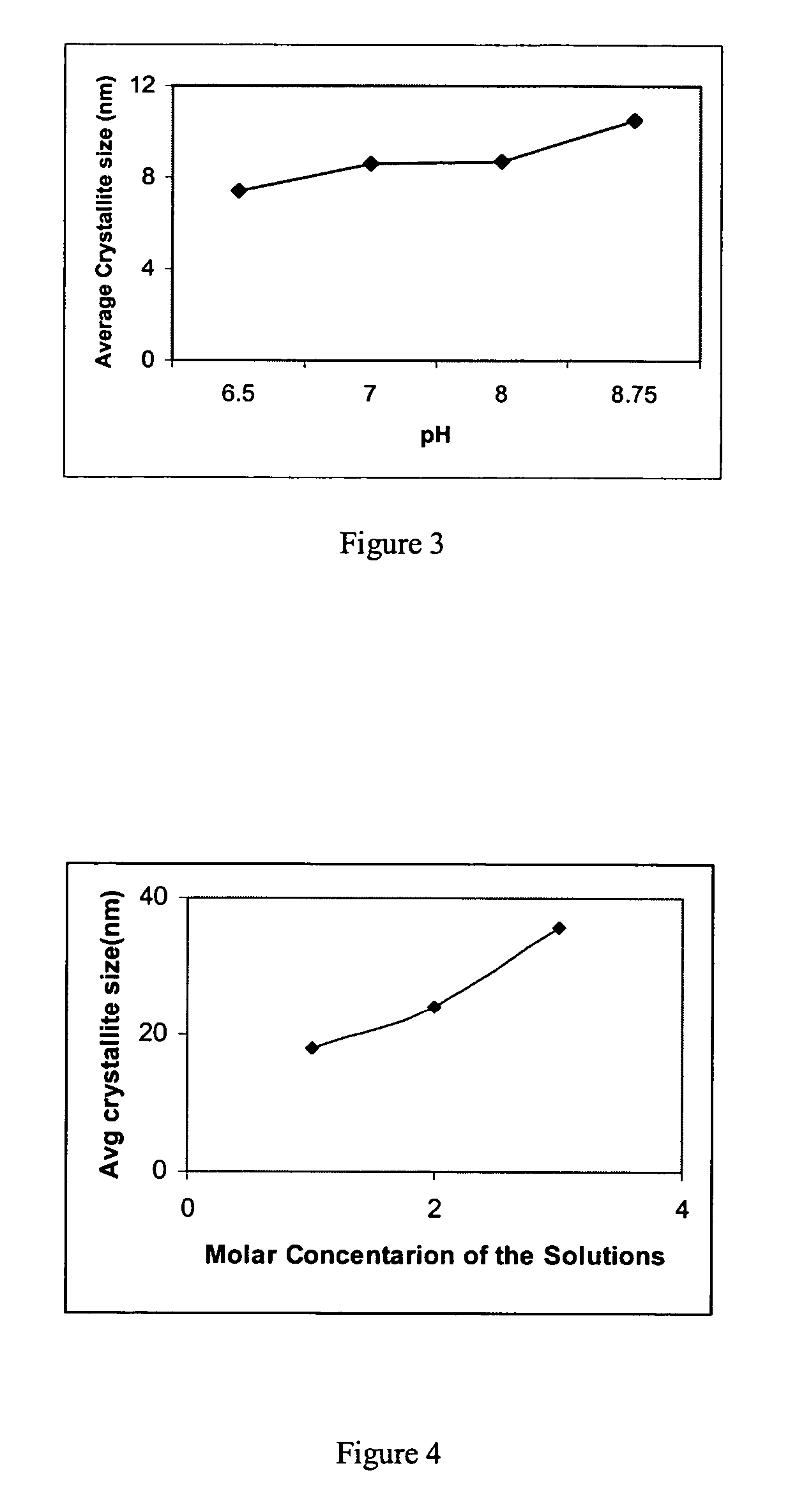Attrition resistant bulk metal catalysts and methods of making and using same
a bulk metal catalyst, attrition resistance technology, applied in the direction of catalyst activation/preparation, metal/metal-oxide/metal-hydroxide catalyst, physical/chemical process catalyst, etc., can solve the problem of increasing the cost of natural gas, reducing the natural resource of crude oil used for liquid fuels such as gasoline and middle distillates, and presenting technological challenges. problem, to achieve the effect of high catalyst attrition resistan
- Summary
- Abstract
- Description
- Claims
- Application Information
AI Technical Summary
Benefits of technology
Problems solved by technology
Method used
Image
Examples
example 1
Variation of Surface Area With Calcination Temperature; and Comparison of Unpromoted Catalyst and Zirconia Promoted-Catalyst
[0086]Precipitated cobalt catalysts were prepared at a constant pH of 7.0 using 1.0-M solution of Co(NO3)3.6H2O and Zr(NO3)3.xH2O in the desired Co / Zr ratio, which was precipitated by adding 1.0 M ammonium carbonate solution. 5% zirconia was added as a textural promoter. The precipitate was then thoroughly washed with deionized water by vacuum filtration. The wet cake was then drived in an oven at 110° C. overnight followed by calcination at different temperature in the range of 300–900° C. for three hours. Results are listed in Table 1 and illustrated in FIG. 1. As indicated by Table 1 and as shown in FIG. 1, the BET surface area was higher for the zirconia promoted catalyst than for the unpromoted catalyst.
[0087]
TABLE 1Properties of precipitated bulk cobalt catalystsWith No ZrWith ZrCalcination TempBET Surface Area,BET SurfaceAvg. crystallite° C.m2 / gArea, m2 / ...
example 2
Variation of Average Crystallite Size with Calcination Temperature
[0088]The average CO3O4 crystallite sizes for the Zr promoted cobalt catalysts prepared in Example 1 were calculated from x-ray diffraction (XRD). The results are listed in Table 1 and illustrated in FIG. 2. From Table 1 and as shown in FIG. 2, it is clear that the average crystallite size increases with the increase in calcination temperatures.
example 3
Variation of Average Crystallite Size with Precipitation pH
[0089]Precipitated cobalt catalysts were prepared using 1.0-M solution of Co(NO3)3.6H2O, which was precipitated by adding 1.0 M ammonium carbonate solution. The precipitation pH level was varied from 6.5 to 9.0. The precipitate was then thoroughly washed with deionized water by vacuum filtration. The wet cake was then dried in an oven at 110° C. overnight, and finally calcined at 300° C. for 2 hours. The results are listed in Table 2. As seen in Table 2, as the pH increases, the surface area decreases. Both the pore volume and the average pore diameter increases as the pH increases from 6.5 to 8.0. Further increase in pH resulted in reduced pore volume and pore diameter. The results listed in Table 2 for variation of average crystallite size vs pH are illustrated in FIG. 3. As seen in FIG. 3, the average crystallite size increases as the pH increases.
[0090]
TABLE 2Properties of precipitated bulk cobalt catalystsBET SurfacePor...
PUM
| Property | Measurement | Unit |
|---|---|---|
| size | aaaaa | aaaaa |
| BET surface area | aaaaa | aaaaa |
| wt. % | aaaaa | aaaaa |
Abstract
Description
Claims
Application Information
 Login to View More
Login to View More - R&D
- Intellectual Property
- Life Sciences
- Materials
- Tech Scout
- Unparalleled Data Quality
- Higher Quality Content
- 60% Fewer Hallucinations
Browse by: Latest US Patents, China's latest patents, Technical Efficacy Thesaurus, Application Domain, Technology Topic, Popular Technical Reports.
© 2025 PatSnap. All rights reserved.Legal|Privacy policy|Modern Slavery Act Transparency Statement|Sitemap|About US| Contact US: help@patsnap.com


